CR123A and rechargeable substitutes

This article will be looking at CR123 batteries and some recharge batteries that are supposed to be replacements for CR123 batteries.
The CR123 battery was made for use in cameras, where the high current capacity was very useful for the flash and for the motor drive (Back in the film days). Surefire did like the battery size and introduced it in flashlights (Around 1988). This made small and bright flashlights possible.
Naming
The correct name is CR123A and this name might be because it is 2/3 of the A battery size (The A battery is not used anymore). Often the battery is only called CR123, sometimes only 123 or 123A.
Rechargeable batteries that has about the same size is often called RCR123 or R123, this naming is done to signal that they can replace a CR123 (That is not always the case). Another name for that size batteries is 16340, first two digits is diameter and last 3 digits is length in 1/10mm (The diameter will often be 0.5mm more than the number specify, the length can be a couple of mm more). 17335 or 17345 can also be used for this size battery.
The 18350 battery is not really a replacement for CR123, it has to large a diameter, but when working with flashlights a few are large enough to fit a 18350. The 1 mm length difference (xx340 to xx350) will seldom be significant.
Performance comparison to other primary batteries
Lets compare performance of this battery to ordinary alkaline AA batteries:
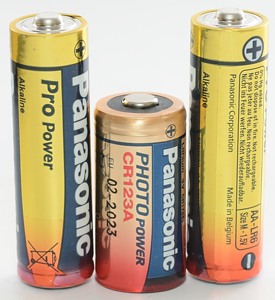
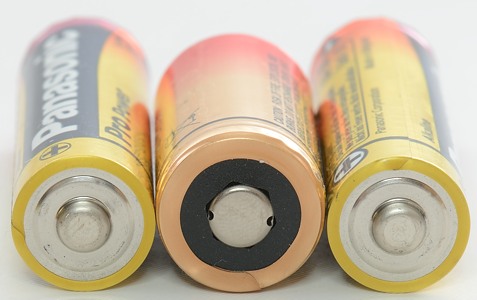
To get roughly the same voltage, two AA cells are needed.
The size of CR123 is about 16.5 mm in diameter and 34 mm in length, the AA is 14 mm in diameter and 50 mm in length and a CR123 weight less than a single AA battery.
How does these batteries compare, when drawing power:
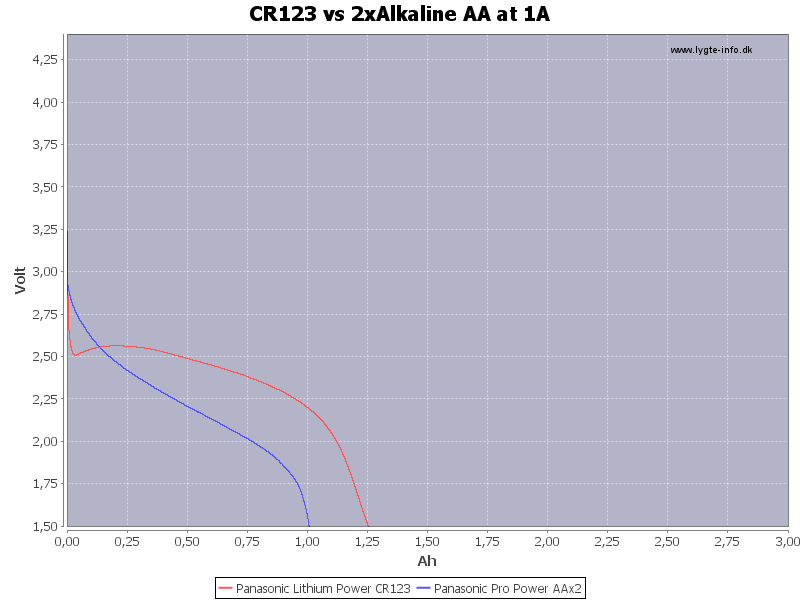
At 1A the CR123 has higher voltage (most of the time) and more capacity, making it much better for a high power flashlight than a couple of Alkaline AA batteries.
But the CR123 battery does not always win against Alkaline, at lower loads Alkaline AA has more capacity, but cannot match the voltage of CR123.
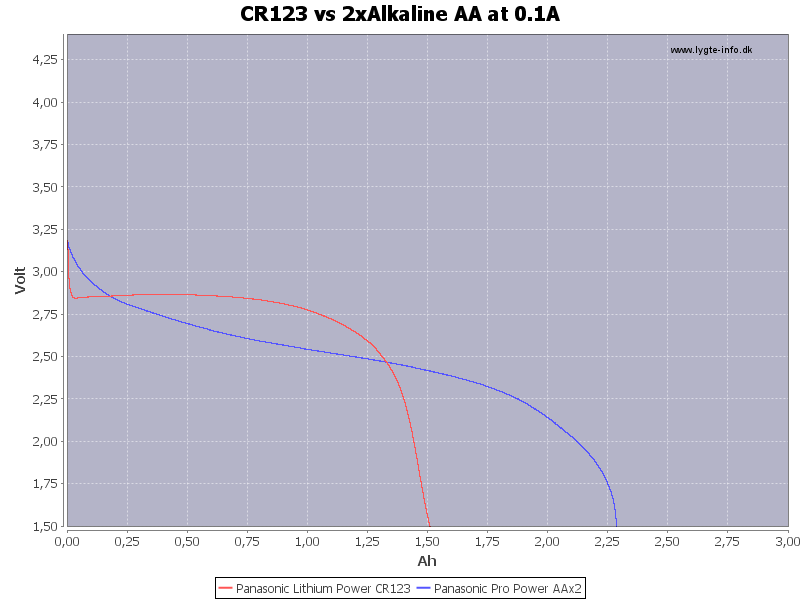
The CR123 cannot match the capacity of two AA, when using more modern AA batteries (Lithium and NiMH):
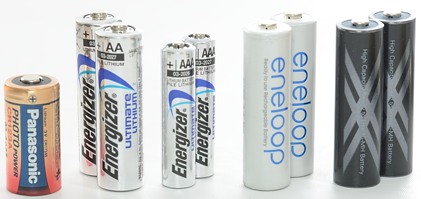


The conclusion of the above curves must be that CR123 can easily match two Alkaline AA batteries, when used in a high power flashlight, but needs much less space. When Using more modern battery chemistries, the advantage of CR123 is more the size and voltage, not as much energy or power.
RCR123 and 16340
Making a rechargeable CR123 is just about impossible, none of the common battery chemistries has the same voltage. There are a couple of ways to handle that, none of them ideal, i.e. a RCR123 battery is NEVER a direct replacement, but will often work.
The 3 common ways to make a RCR123/16340 battery is:
- Use a normal LiIon battery with LiCoO2 (ICR) or LiMn (IMR) chemistry in 16340 size, preferable with a protection circuit (This might make the battery to long). This battery will have 4.2 volt fresh of the charger and will be empty when the voltage is down to about 3 volt. This voltage does not match very well with CR123 that has a maximum voltage of 3.2 volt and is below 3 volt when loaded.
- Use a normal LiIon battery in 16340 size, but add a diode in series with the battery. This will reduce the output voltage with about 0.6 to 0.7 volt. The voltage will be close to CR123, but still too high and the diode will heat the battery at high loads.
- Use LiFePO4 (IFR) chemistry, this chemistry has a lower voltage than normal LiIon, but also less capacity. It does also survive over discharge better, i.e. protection circuit is not that important.
All of the 3 battery types above, does have different charger requirements:
- These batteries can be charger on any regular LiIon charger, i.e. 4.2 volt max. and 3.6 or 3.7 volt nominal.
- Due to the diode, the charger must supply higher voltage to get full capacity, but they can be charger with a regular LiIon charger.
- This chemistry requires a 3.6 volt max. charger, they are usual marked 3 or 3.2 volt.
With led flashlights there is also another "problem", the led needs between 3 and 3.7 volt. A flashlight designed for a single CR123 needs a control circuit that can increase voltage (boost), this means that any battery with more than that voltage will prevent the boost regulator from regulating. Flashlights designed for this usual list two different lumen values, one for CR123 and one for LiIon. When the boost regulator is bypassed, due to the battery voltage, the current will depend on the actual battery voltage, this can overheat the led, especially with a new and good battery. To avoid this, only run the light a few second at full power, when using a recently charged 4.2 volt battery.
Some lights has a buck/boost regulator, i.e. they can both increase and decrease battery voltage, in this case there will not be any heat problems.
ICR (LiCoO2) and IMR (LiMn)
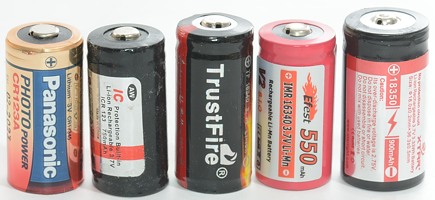
The voltage from this chemistry is way above the voltage from CR123, i.e. do not use these batteries, except on equipment designed for this higher voltage. Protected batteries are often longer than CR123, but there are exceptions (Like AW). The 18350 has a larger diameter.
The capacity is much lower than the CR123, even the 18350 battery has lower capacity (But more energy, due to the higher voltage).
When using these batteries in CR123 flashlight the brightness will usual be higher and the runtime even shorter than the lower capacity suggest.
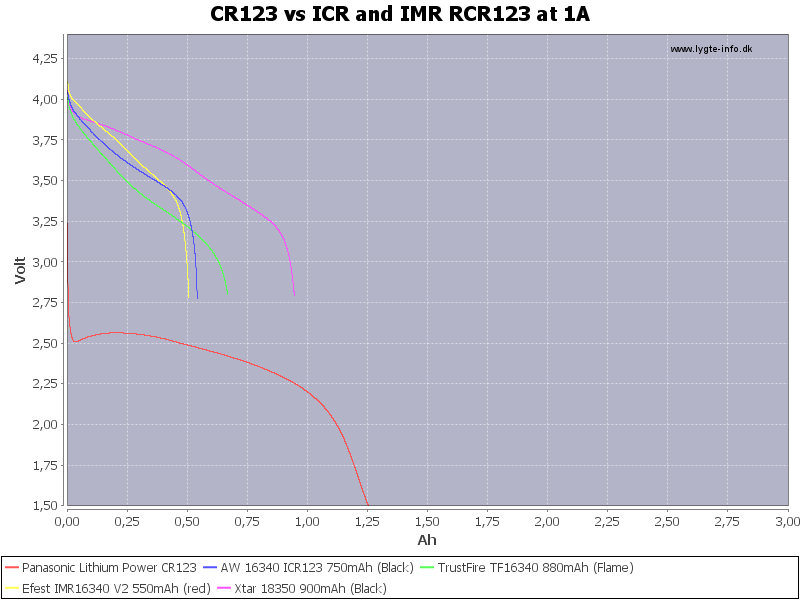
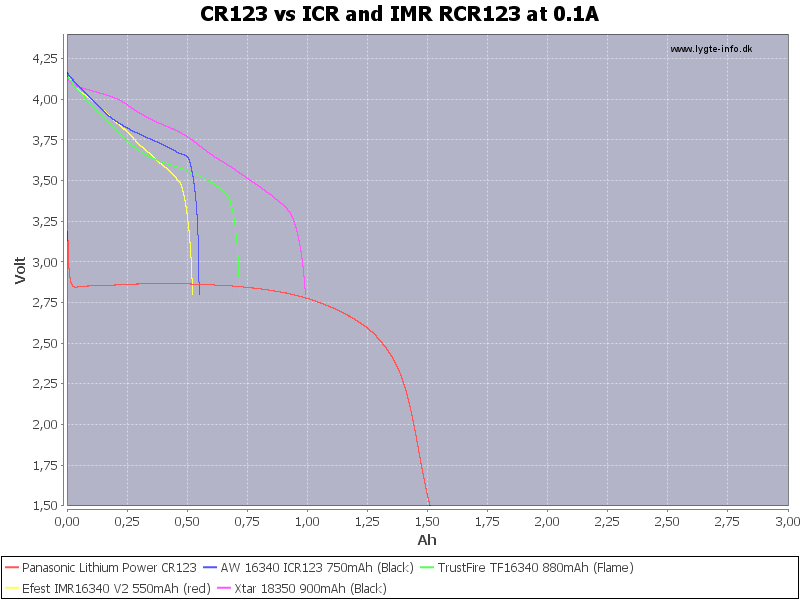

ICR (LiCoO2) with diode
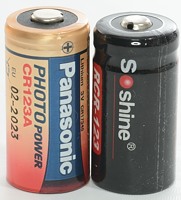
I have only included one battery in this category, I could not find others, probably due to wrong specifications.
Soshine does also have wrong specifications: It says charge voltage is 3.6 volt, where it must be higher to get full capacity. I did my test with 4.2 volt charger voltage (3.6 volt nominal) and this means that I did not get the full capacity or voltage.
This battery is without protection, this makes the size very close to the CR123 size, but it is a problem if the battery is discharged completely.
With the low charge voltage the battery is a fairly good replacement for a CR123 battery, but with much lower capacity.
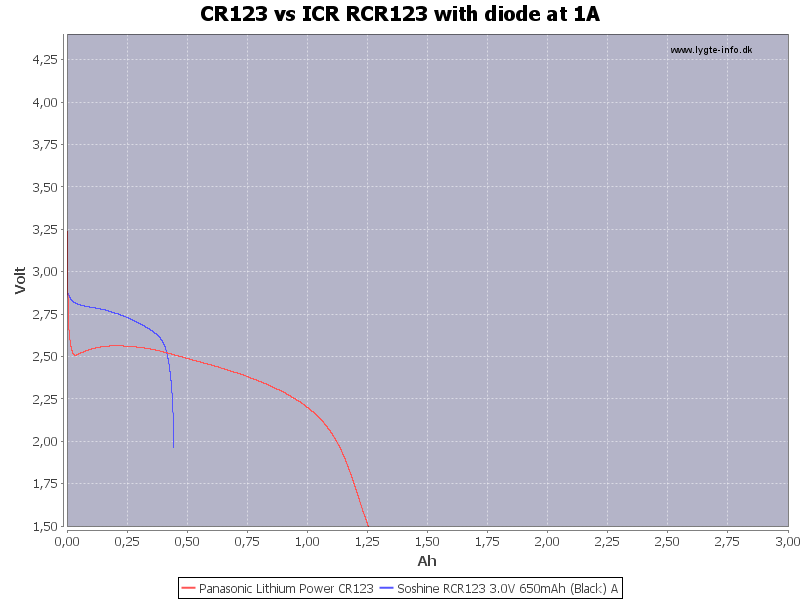
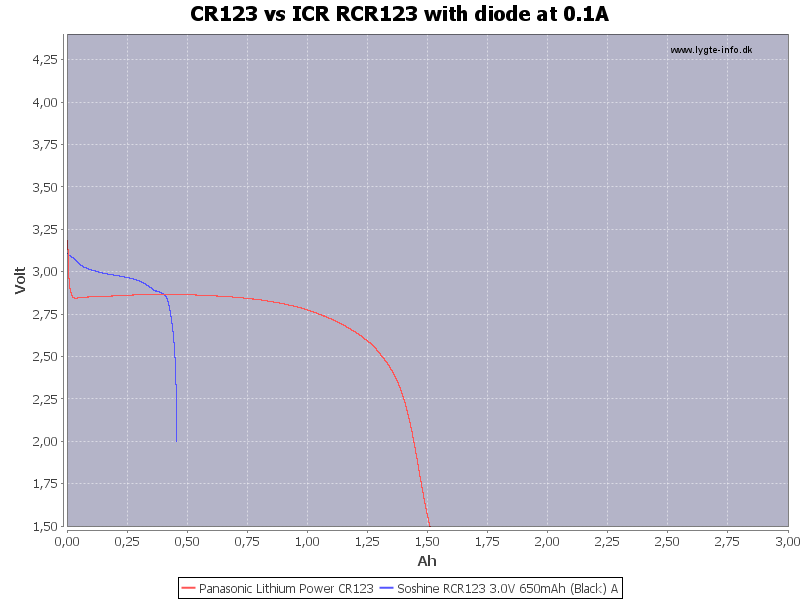

IFR (LiFePO4)
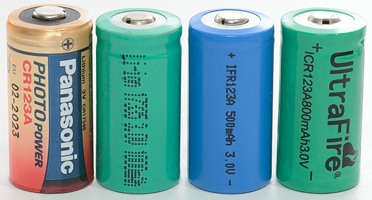
IFR batteries has around 3.2 volt, and lower capacity than ICR batteries. These batteries will be around 3.2 volt, even when loaded, where CR123 drops below 3 volt.
These batteries is without protection and the size is very close to a CR123 battery.
Notice that the Ultrafire battery is marked ICR, but it is a IFR battery.
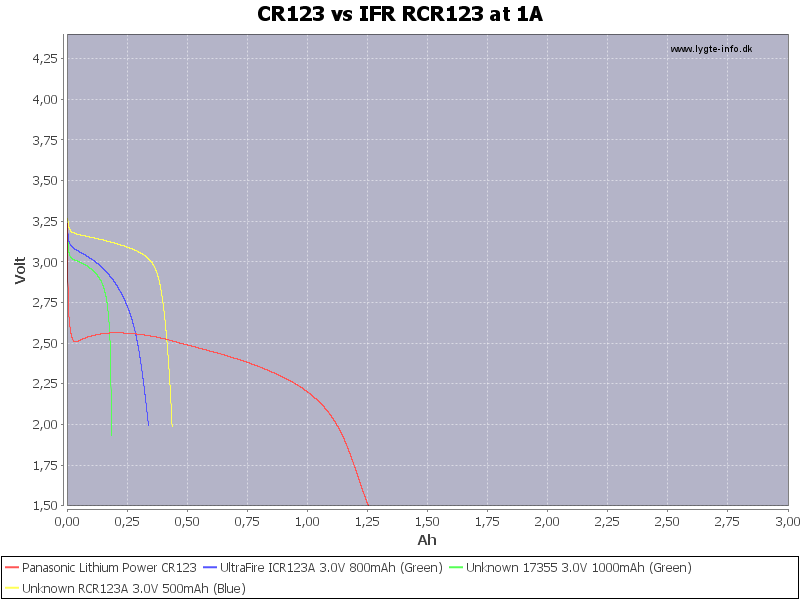
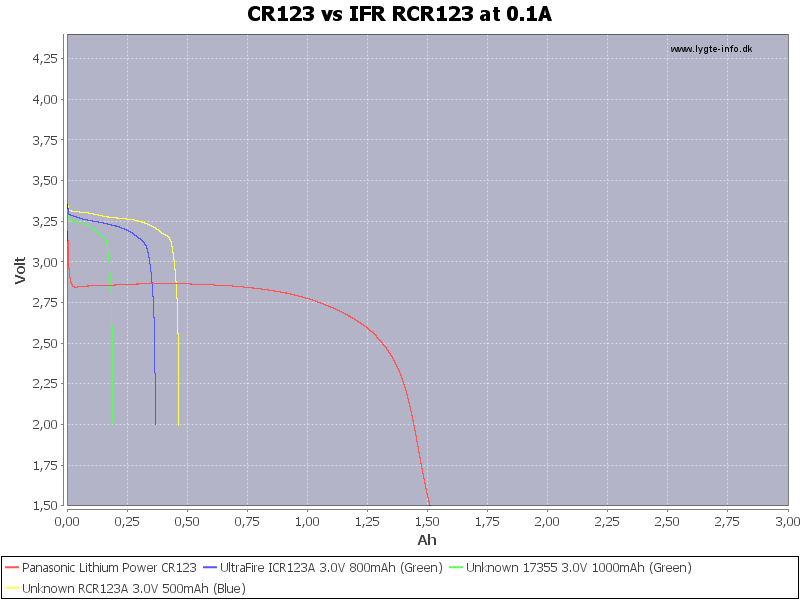

Substitutes for multiple CR123
For lights using multiple CR123, the obvious substitute would be more RCR123 batteries, but that is usual a bad idea. To avoid over discharge and reverse charge, the batteries must be protected, this means ICR batteries with up to 4.2 volt. I.e. the voltage will be significantly higher (Check the specifications for the light, if it is allowed).
There are some other substitutes that can sometimes be used:
Two CR123 in series

The length of two CR123 is close to a xx650 battery with protection. The xx650 battery has considerable lower voltage than two CR123 batteries, but many lights will work with it, often with a slightly reduced brightness (this gives longer runtime). Because the voltage of the LiIon battery is lower, it is always safe to do a test.
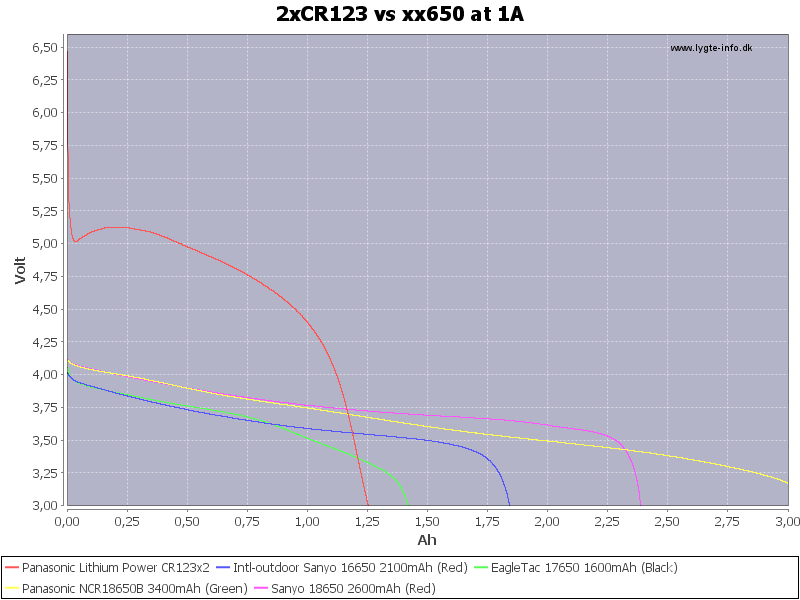
The 16650 battery is usual the best choice, except if the light has a large diameter tube, then the 18650 is much better.

3. CR123 in series
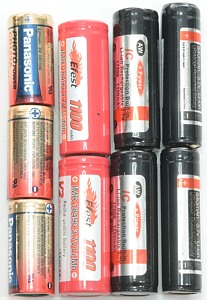
The length of two xx500 batteries is very close to 3xCR123.
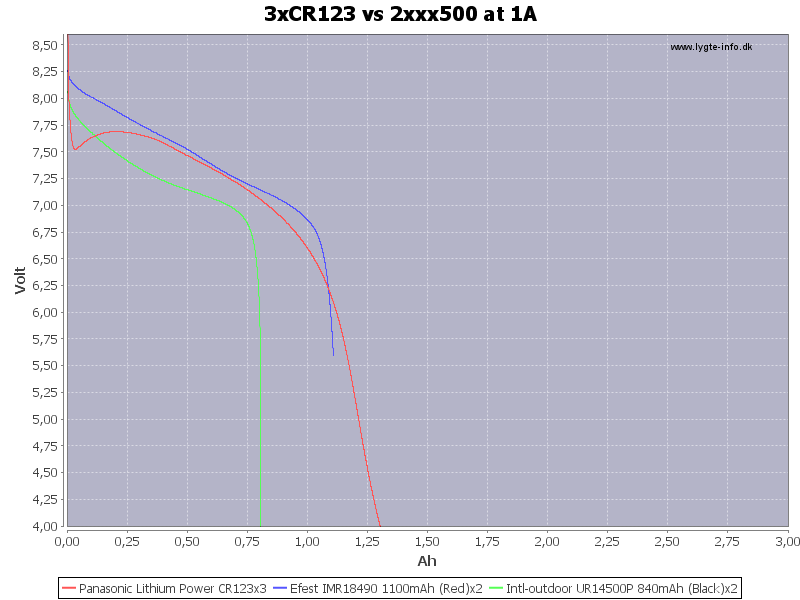
As can be seen on the curves the voltage are also very close, i.e. as long as the batteries fit, it will work.

Two xx500 batteries cannot match 3xCR123 in capacity or energy, but are not that far behind.
Conclusion
There is no easy solution for rechargeable CR123, in each case it is necessary to investigate the equipment for what types can be used.
- 1 CR123: The solution with most capacity is protected ICR 16340 batteries and the easiest solution is IFR batteries.
- 2 CR123: If possible use a xx650 battery, alternate possibility is 2x protected ICR 16340.
- 3 CR123: If possible use 2x xx500 batteries, alternate possibility is 3x protected ICR 16340.
In all of the above cases there can be size and voltage issues.
Battery reviews
AA rechargeable
Eneloop AA HR-3UTGB 1900mAh (White)
Eneloop AA HR-3UWXB 2450mAh (Black)
CR123
Panasonic Lithium Power CR123
ICR (LiCoO2) and IMR (LiMn)
Xtar 18350 900mAh (Black)
AW 16340 ICR123 750mAh (Black)
TrustFire TF16340 880mAh (Flame)
Efest IMR16340 V2 550mAh (red)
ICR (LiCoO2) with diode
Soshine RCR123 3.0V 650mAh (Black)
IFR (LiFePO4)
UltraFire ICR123A 3.0V 800mAh (Green)
Unknown 17355 3.0V 1000mAh (Green)
Unknown RCR123A 3.0V 500mAh (Blue)